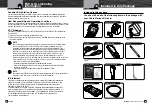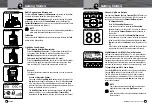
Introduction
5
Nothing
Comes Close to a Cobra
®
FCC Licensing Information
FCC Licensing Information
•
CobraMarine VHF radios comply with the FCC (Federal Communications Commission)
requirements that regulate the Maritime Radio Service.
This CobraMarine radio incorporates a VHF FM transceiver designed for use in the frequency
range of 156.025 to 163.275 MHz. It has a switchable RF output power of one (1), three (3)
or six (6) watts.
The transceiver is capable of Class-D (Digital Selective Calling) operation in accordance with
CFR Part 47, Section 80,225.
The radio operates on all currently allocated marine channels and is switchable for use
according to U.S.A., International or Canadian regulations. It features instant access to
emergency Channel 16 and calling Channel 9 as well as NOAA (National Oceanic and
Atmospheric Administration) All Hazards Radio with Alert.
Station License
An FCC ship station license is no longer required for any vessel traveling in U.S.A. waters which
uses a VHF marine radio, RADAR, or EPIRB (Emergency Position Indicating Radio Beacon), and
which is not required to carry radio equipment. However, any vessel required to carry a marine
radio on an international voyage, carrying an HF single side band radiotelephone, or carrying a
marine satellite terminal must obtain a station license.
FCC license forms and applications for ship and land stations can be downloaded through the
Internet at www.fcc.gov. Forms can also be obtained by calling the FCC at 888-225-5322.
International Station License
If your vessel will be entering the sovereign waters of a country other than the U.S.A. or Canada,
you should contact that country’s communications regulatory authority for licensing information.
Radio Call Sign
Currently, the FCC does not require recreational boaters to have a license. The United States
Coast Guard recommends that the boat’s registration number and state of registry (e.g., IL 1234
AB) be used as a call sign and be clearly visible on the vessel.
4
English
General Precautions
Introduction
NOTICE
Your radio is waterproof only when the batteries are properly installed.
AVOID
using or storing the radio at temperatures below -4˚F (-20˚C) or above
140˚F (60˚C).
KEEP
your radio at least 3 ft (0.9 m) away from your vessel’s magnetic
navigation compass.
DO NOT
attempt to service any internal parts yourself. Have any necessary
service performed by a qualified technician.
This radio is supplied with a lithium-ion (LiON) rechargeable battery pack.
n
Use only the Cobra charger to recharge lithium-ion (LiON) batteries in the radio.
n
Do not short circuit the battery pack.
n
When replacing the batteries, dispose of the old batteries properly. Batteries
may explode if disposed of in a fire.
CAUTION
Risk of explosion if battery is replaced by an incorrect type. Dispose of used
batteries according to the instructions.
Changes or modifications to your radio MAY VOID its compliance with
FCC (Federal Communications Commission) rules and make it illegal to use.
Recommendations for Marine Communication
•
The frequencies your radio uses are set aside to enhance safety afloat and for vessel
navigation and operational messages over a range suitable for nearshore voyages.
If the 6 watt maximum output of your radio is not sufficient for the distances you travel from
the coast, consider installing a Cobra Marine fixed mount radio with up to 25 watts of
output power. (Visit www.cobra.com or your local dealer for model availability.)
If traveling far offshore, you should consider adding even more powerful radio equipment
such as HF single side band or satellite radio for your vessel.
The U.S. Coast Guard does not endorse cellular telephones as substitutes for marine
radios. They generally cannot communicate with rescue vessels and, if you make
a distress call on a cellular telephone, only the party you call will be able to hear you.
Additionally, cellular telephones may have limited coverage over water and
can be hard to locate. If you do not know where you are, the Coast Guard will have difficulty
finding you if you are using a cellular telephone.
However, cellular telephones can have a place on board where cellular coverage
is available — to allow social conversations and keep the marine frequencies
uncluttered and available for their intended uses.
Introduction






































